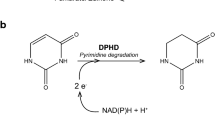Summary
The LYS5 and LYS2 genes of Saccharomyces cerevisiae are required for the synthesis of α-aminoadipate reductase in the lysine pathway. The LYS5 gene, originally cloned as a DNA insert of the plasmid pSC5, has been subcloned on a 3.2 kb SphI-Sau3AI DNA fragment of the recombinant plasmid pSR7. An internal 2.1 kb HpaI-HpaI DNA fragment of the subclone, upon Southern hybridization, exhibits homology with HpaI-restricted wild-type S. cerevisiae genomic DNA. The lys5 + transformants exhibited α-aminoadipate reductase activity similar to that of wild-type cells. S1 nuclease analysis localizes the transcription initiation site relative to the detailed restriction map, and reveals the direction of transcription, as well as the transcript size of the LYS5 gene which can be no greater than 1.65 kb. From this it is estimated that the encoded polypeptide is appreciably smaller than the 4 kb LYS2 gene product. These results provide a physical and biochemical characterization of the cloned LYS5 gene. Based on these observations, it is concluded that the LYS5 gene encodes a relatively small polypeptide of the large heteropolymeric α-aminoadipate reductase.
Similar content being viewed by others
References
Barnes DA, Thorner J (1986) Mol Cell Biol 6:2828–2838
Berk AJ, Sharp PA (1977) Cell 12:721–732
Bhattacharjee JK (1985) CRC Crit Rev Microbiol 12:131–151
Birnboim HC, Doly J (1979) Nucleic Acids Res 7:1513–1525
Biswas GD, Bhattacharjee JK (1974) Antonie Van Leeuwenhoek J Microbiol Serol 40:221–231
Borell CW, Bhattacharjee JK (1988) Curr Genet 13:299–304
Broquist HP (1971) Methods Enzymol 17B:112–129
Chattoo B, Sherman F, Azubalis D, Fjellstedt T, Mehnert D, Ogur M (1979) Genetics 93:51–65
Eibel H, Philippsen P (1983) Mol Gen Genet 191:66–73
Fjellstedt T, Ogur M (1970) J Bacteriol 101:108–117
Fleig UN, Pridmore RD, Philippsen P (1986) Gene 46:237–245
Haynes JR, Rosteck P, Schon EA, Gallagher PM, Burks DJ, Smith K, Lingrel JB (1980) J Biol chem 255:6355–6367
Heslot HC, Gaillardin M, Beckerich JM, Fournier P (1979) In: Sebek OK, Laskin AI (eds) Genetics of industrial microorganisms, Am Soc Microbiol, Washington D.C., pp 54–60
Hwang YL, Lindegren G, Lindegren CC (1966) Can J Genet Cytol 8:471–480
Ito H, Fukuda Y, Murata K, Kimura A (1984) J Bacteriol 153:163–168
Kunze G, Bode R, Schmidt H, Samsonova IA, Birnbaum D (1987) Curr Genet 11:385–391
Li W, Okamoto S, Bhattacharjee JK (1989) Curr Genet 16:7–12
Lowry OH, Rosenbrough NJ, Farr AL, Randall RJ (1951) J Biol Chem 193:265–275
Mandel M, Higa A (1970) J Mol Biol 53:159–162
McDonnell MW, Simon MN, Studier FW (1977) J Mol Biol 110:119–146
Miller KG, Sollner-Webb B (1981) Cell 27:165–174
Morris ME, Jinks-Robertson (1991) Gene 98:141–145
Norgard MV, Emigholz K, Monahan JJ (1979) J Bacteriol 138:270–272
Rigby PWJ, Diekman M, Rhodes C, Berg P (1977) J Mol Biol 113:237–251
Robbins J, Rosteck P, Haynes JR, Freyer G, Cleary ML, Kelter HD, Smith K, Lingrel JB (1979) J Biol Chem 254:6187–6195
Sagisaka S, Shimura K (1960) Nature 184:1709–1710
Sambrook J, Fritsch EF, Maniatis T (1989) Molecular cloning: A Laboratory Manual, Cold Spring Harbor Laboratory, Cold Spring Harbor, New York
Sherman F, Fink GR, Hicks JB (1986) Methods in Yeast Genetics, Cold Spring Harbor Laboratory, Cold Spring Harbor, New York
Sinha AK, Bhattacharjee JK (1970) Biochem Biophys Res Commun 39:1205–1210
Sinha AK, Bhattacharjee JK (1971) Biochem J 125:743–749
Smith HO, Birnstiel ML (1976) Nucleic Acids Res 3:2387–2398
Storts DR, Bhattacharjee JK (1989) Biochem Biophys Res Commun 161:182–186
Ye ZH, Bhattacharjee JK (1988) J Bacteriol 170:5968–5970
Author information
Authors and Affiliations
Additional information
Communicated by K. Wolf
Rights and permissions
About this article
Cite this article
Rajnarayan, S., Vaughn, J.C. & Bhattacharjee, J.K. Physical and biochemical characterization of the cloned LYS5 gene required for α-aminoadipate reductase activity in the lysine biosynthetic pathway of Saccharomyces cerevisiae . Curr Genet 21, 13–16 (1992). https://doi.org/10.1007/BF00318647
Received:
Accepted:
Issue Date:
DOI: https://doi.org/10.1007/BF00318647




